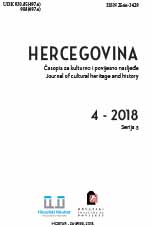Nikolo intaglio kao primjer značenja i važnosti dragoga kamena i njegove imitacije u staklu u antičkom periodu
Nicolo intaglio as an Example of Significance and Symbolism of Gems and Their Glass Imitation in the Ancient World
Author(s): Ivanka Ribarević-NikolićSubject(s): History, Archaeology, Ancient World
Published by: Filozofski fakultet Sveučilišta u Mostaru - Studij povijesti i Hrvatski institut za povijest - Zagreb
Keywords: gemmology; archaeology; nicolo; gems; glass intaglio
Summary/Abstract: An interdisciplinary approach to the research of gemmology and archaeology has discovered a variety of information which simultaneously enrich the achievements of both disciplines. This paper highlights the importance of gems, especially in the Ancient World. From the gemmological aspect, a gem is natural if all of its natural features are preserved. Also, we describe gems with some of their original characteristics modified in certain treatments, most frequently the change of natural gem colour. Furthermore, we show how the imitations of gems are created with the use of natural or artificial materials. Nicolo is taken as an example. It is onyx, of specific bluish white upper layer and very dark brown or black lower layer. It is assumed that nicolo can be identified with the antique stone that Pliny the Elder called aegyptilla. Nicolo became popular stone for intaglio carving at the time of the Empire, especially since the Augustan era, and was continuously used until the late antiquity. At the same time, imitations of nicolo intaglio in glass were produced which, with the colour (light blue and black combined) and the shape, followed the changes of the cutting techniques of the original intaglio. The main changes of shape were shown in a variety of nicolo cutting methods, with one or both colours of the stone being visible on the surface. When the edges are cut at right angles, only the upper blue layer of stone is visible on the surface of the intaglio. Nicolo intaglio with the edges cut at acute angles can contrast the colours of both layers of the stone. As a result, the blue colour in the centre, always containing a picture, is surrounded by darker colours of the lower layer of the stone. Glass imitations of nicolo intaglio were found in the combinations of light blue and dark blue. Dark blue colour is not typical for natural nicolo or natural onyx in general. With the "sugar-acid" treatment, the onyx of grey and white colours was changed to resemble nicolo onyx, and probably this atypical colour combination of different blue shades was imitated in glass. It is believed that precious stone has a supernatural protective power manifested in its specific substance and its invisible energy. The long continuity of making and using nicolo intaglio and their imitations points to the importance of this precious stone as well as its imitation. We would like to point out that an imitation, same as natural precious stone, possesses the equal supernatural power. A philosophical concept of sympatheia was taken as an example, according to which "likeness produces similarity", meaning that the objects which were once in contact continue to impact each other at a distance, even though physical contact was interrupted. Thus, according to the philosophical concept of sympatheia, the glass imitation shows resemblance, i.e. a glass intaglio that imitates nicolo, is similar to nicolo stone. The picture message which is always present in intaglio, was obtained by imprint of an original precious stone. Thus, the original precious stone, together with the picture, was in contact with a medium used to produce glass intaglio, and therefore, even at distance and indirectly, conveys the acting power of the original substance. Consequently, the imitation possesses all the invisible energy features as the original. Certainly, this assumption requires further research, primarily based on the gemmological analysis of stylistic and chronological typology of the museum artefacts and the identification of precious stone imitations, with equally important information from written sources as well as philosophical and anthropological studies.
Journal: Hercegovina. Časopis za kulturno i povijesno naslijeđe (od 2018)
- Issue Year: 2018
- Issue No: 4
- Page Range: 7-30
- Page Count: 24
- Language: Croatian

